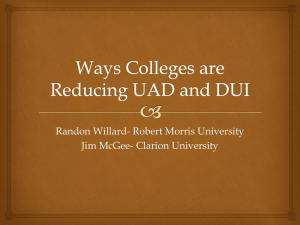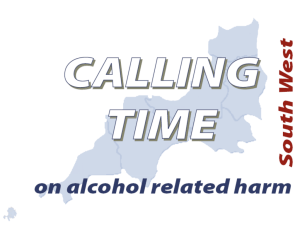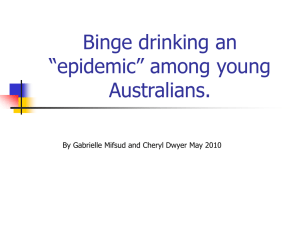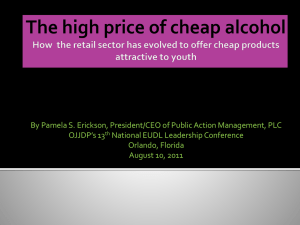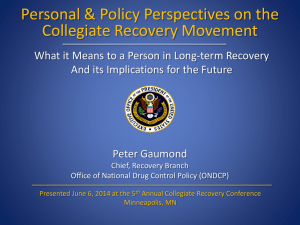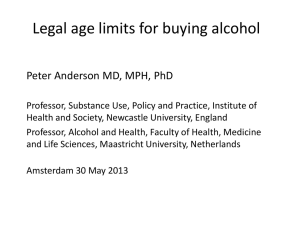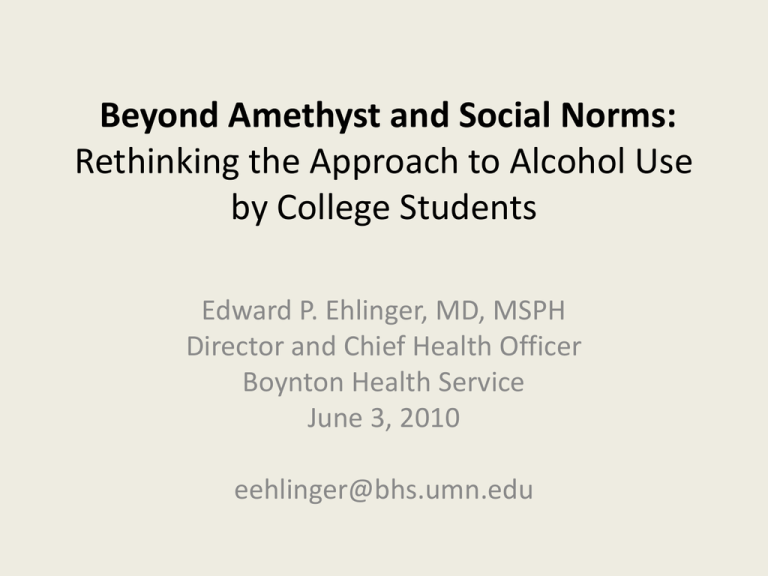
Beyond Amethyst and Social Norms:
Rethinking the Approach to Alcohol Use
by College Students
Edward P. Ehlinger, MD, MSPH
Director and Chief Health Officer
Boynton Health Service
June 3, 2010
eehlinger@bhs.umn.edu
On June 3, 1800
• President John Adams left
Philadelphia and took up
residence in Washington, D.C.
• His residence was Union Tavern
in Georgetown because the
White House wasn’t completed.
Dealing with alcohol is my least
favorite part of college health
• There is lack of consensus that alcohol
use by college students is a big problem
• We have not been successful in reducing
the toll that alcohol takes on college
students.
• Our society doesn’t want to really
address the problems caused by alcohol.
Alcohol Tolerant Attitudes
Percentage of adults drinking 5 or more drinks
on an occasion one of more times in last month
CDC: BRFSS, 2004
Franz Kafka died on June 3, 1924
• “In the fight
between you and
the world, back
the world.”
But, we can’t ignore the problems that
alcohol causes college students
– The data show that alcohol is taking a toll on
students
– People expect us to address it
– There are some things that we can do that are
effective – at least on an individual level, if not on
a population level
– College health has more power and influence than
we realize – we can make a difference if we focus
on the right things.
• On June 3, 1888 the poem “Casey at the
Bat,” by Ernest Lawrence Thayer, was
published by the San Francisco Examiner.
• I hope I don’t strike out in my attempt to
outline a slightly different approach to
alcohol.
• Oh, somewhere in this favored land the sun is shining bright;
The band is playing somewhere, and somewhere hearts are light,
And somewhere men are laughing, and somewhere children shout;
But there is no joy in Philadelphia, Ed Ehlinger has struck out.
June 3 is the Feast of Bellona
• Bellona was an Ancient Roman
war goddess. She is believed to
be one of the numinous gods
(present in places and objects).
She is thought by many to have
been the Romans' original war
deity, predating the identification
of Mars. She is also the mother of
Romulus and Remus, The
legendary founders of Rome.
Bellona by Rodin
Philadelphia
Museum of Art
We are in a war with alcohol
• Death: 1,700 college students between the ages of 18 and 24
die each year from alcohol-related unintentional injuries,
including motor vehicle crashes
• From 1998 to 2001, alcohol-related unintentional injury
deaths per 100,000 college students increased by 6%.
• Injury: 599,000 students between the ages of 18 and 24 are
unintentionally injured under the influence of alcohol
• Assault: More than 696,000 students between the ages of 18
and 24 are assaulted by another student who has been
drinking
• Sexual Abuse: More than 97,000 students between the ages
of 18 and 24 are victims of alcohol-related sexual assault or
date rape
•
College Drinking: Changing the Culture - NIAAA
http://collegedrinkingprevention.gov/StatsSummaries/snapshot.aspx
We are in a war with alcohol
• Health Problems/Suicide Attempts: More than 150,000 students develop an
alcohol-related health problem and between 1.2 and 1.5 percent of students
indicate that they tried to commit suicide within the past year due to drinking or
drug use
• Drunk Driving: 2.1 million students between the ages of 18 and 24 drove under
the influence of alcohol last year
• The proportion of 18- to 24-year-old college students who reported driving
under the influence of alcohol increased by 20%
• Vandalism: About 11 percent of college student drinkers report that they have
damaged property while under the influence of alcohol
• Property Damage: More than 25 percent of administrators from schools with
relatively low drinking levels and over 50 percent from schools with high drinking
levels say their campuses have a "moderate" or "major" problem with alcoholrelated property damage
•
College Drinking: Changing the Culture - NIAAA
http://collegedrinkingprevention.gov/StatsSummaries/snapshot.aspx
We are in a war with alcohol
• Police Involvement: About 5 percent of 4-year college students are involved with
the police or campus security as a result of their drinking and an estimated
110,000 students between the ages of 18 and 24 are arrested for an alcoholrelated violation such as public drunkenness or driving under the influence
• Alcohol Abuse and Dependence: 31 percent of college students met criteria for a
diagnosis of alcohol abuse and 6 percent for a diagnosis of alcohol dependence
in the past 12 months, according to questionnaire-based self-reports about their
drinking
• Unsafe Sex: 400,000 students between the ages of 18 and 24 had unprotected
sex and more than 100,000 students between the ages of 18 and 24 report
having been too intoxicated to know if they consented to having sex
• Academic Problems: About 25 percent of college students report academic
consequences of their drinking including missing class, falling behind, doing
poorly on exams or papers, and receiving lower grades overall
• College Drinking: Changing the Culture - NIAAA
http://collegedrinkingprevention.gov/StatsSummaries/snapshot.aspx
A Matter of Degree Initiative to Reduce Binge
Drinking at Colleges and Universities - RWJF
“Nationwide Strategy to Combat Underage Drinking Requires
Shared Responsibility”
Reducing Underage Drinking: A
Collective Responsibility (2004)
Institute of Medicine
“The consequences of drinking on campus are too damaging to ignore.”
NIAAA - College Drinking Prevention
4 Tiers of Effectiveness
• Tier 1: Evidence of Effectiveness Among
College Students
• Tier 2: Evidence of Success With General
Populations That Could Be Applied to College
Environments
• Tier 3: Evidence of Logical and Theoretical
Promise, But Require More Comprehensive
Evaluation
• Tier 4: Evidence of Ineffectiveness
NIAAA
3-In-1 Framework of Prevention
• The research strongly supports the use of
comprehensive, integrated programs with
multiple complementary components that
target:
– (1) individuals, including at-risk or alcoholdependent drinkers,
– (2) the student population as a whole, and
– (3) the college and the surrounding community
(Hingson and Howland, 2002; DeJong et al., 1998;
Institute of Medicine, 1989).
A Matter of Degree
• A 1996 Robert Wood Johnson Foundation initiative:
• A National Effort to Reduce High-Risk Drinking
Among College Students
• $8.6 million program administered by the American
Medical Association with evaluation by the Harvard
School of Public Health.
• Ten university-community coalitions led a national
effort to reduce high-risk drinking among college
students.
AMOD Schools
•
•
•
•
•
•
•
•
•
•
University of Wisconsin
University of Vermont
University of Nebraska-Lincoln
University of Iowa
University of Delaware
University of Colorado
Louisiana State University
Lehigh University
Georgia Institute of Technology
Florida State University
A Matter of Degree
• Used Tier I and 2 strategies. They also utilized promising
strategies needing evaluation in college environments,
which are characterized by NIAAA as Tier 3. Including:
– Campus policies to reduce high-risk use, such as holding Friday
classes, banning kegs, establishing alcohol-free dorms and
activities
– Increase enforcement at campus-based events
– Publicity about enforcement and elimination of “mixed”
messages
– Consistent disciplinary actions for violations
– Marketing campaigns to correct misperceptions
– Safe-rides programs
– Regulate happy hours and sales or restrict alcohol promotions
– Enhance awareness of personal liability
– Inform parents and new students about policies and penalties
And many other efforts
• On-line courses
• E-Chug
• Social norms campaigns
• The National Social Norms Institute opened
its doors in 2006 at the University of Virginia
to foster research, evaluation, and
dissemination of information on the social
norms approach to the problems caused by
alcohol and other issues.
After all of this and more, what
have been the results?
Have these interventions worked?
Percent of College Students Who Report Being Drunk in the
Past 30 Days
Source: Monitoring the Future, College Students and Adults, 1975-2006, NIH
Are these interventions working?
(5+ drinks in one session past 2 weeks)
19-20 Year Olds
Source: Monitoring the Future, 1975-2006, NIH
Number of Deaths Attributable to the Harmful Effects of Excessive
Alcohol Use Among 18-20 and 21-24 Year Olds:
Alcohol Poisoning 2001-2006
Alcohol Attributable Deaths
(Alcohol Poisoning)
Sources: CDC; Alcohol-Related Disease Impact (ARDI) Software;
Alcohol Attributable Deaths (AAD)
28
30
24
24
21
12
10
21 - 24 Year Olds
19
20
9
10
25
11
10
10
18 - 20 Year Olds
0
2006
2005
2004
2003
2002
2001
Number of Deaths Attributable to the Harmful Effects of
Excessive Alcohol Use Among 18-20 and 21-24 Year Olds:
Non-Highway Injury Deaths 2001-2006
Alcohol Attributable Deaths
(Non-Highway)
Sources: CDC; Alcohol-Related Disease Impact (ARDI) Software;
Alcohol Attributable Deaths (AAD)
300
267
269
255
258
255
260
21 - 24 Year Olds
200
150
151
142
143
141
143
18 - 20 Year Olds
100
0
2006
2005
2004
2003
2002
2001
A Matter of Degree - Evaluation
• “While there was no change in the ten AMOD
schools in study measures, significant
although small improvements in alcohol
consumption and related harms at colleges
were observed among students at the five
AMOD sites that most closely implemented
the environmental model. Fidelity to a
program model conceptualized around
changing alcohol-related policies, marketing,
and promotions may reduce college student
alcohol consumption and related harms.”
Evaluation of Social Norms Programs
• “In a national study, Wechsler and associates
(2003) assessed changes in students’
misperceptions about peer alcohol use and actual
rates of alcohol use at 37 colleges that had
reported implementing social norms campaigns
between 1997 and 2001 as compared to 61
campuses that had not implemented this
approach. They observed no decreases in drinking
rates on campuses that had implemented a social
norms campaign but saw increases in two of the
five drinking measures on these campuses. No
changes in drinking rates were observed in the
comparison colleges.”
Evaluation of Social Norms Programs
• “Given the potential risk of increases in
student alcohol use, campus-wide social
norms campaigns should be implemented
with caution. Any further studies of social
norms campaigns should include multiple
campuses and randomized study designs and
quality of campaign implementation should
be assessed.”
• De-emphasizing the Role of Alcohol and Creating Positive Expectations on
Campus Traci Toomey
Franz Kafka died on June 3, 1924
• “Believing in progress does not
mean believing that any progress
has yet been made.”
• “Kafkaesque”
– Lack of evidence is treated as a
pesky inconvenience
– Situations that are
incomprehensibly complex,
bizarre, or illogical
Amethyst Initiative
A response to lack of progress
• We call upon our elected officials:
– To support an informed and dispassionate public
debate over the effects of the 21 year-old drinking
age.
– To consider whether the 10% highway fund
“incentive” encourages or inhibits that debate.
– To invite new ideas about the best ways to prepare
young adults to make responsible decisions about
alcohol.
– We pledge ourselves and our institutions to playing a
vigorous, constructive role as these critical discussions
unfold.
Jefferson Davis
President of the Confederacy
• Born on June 3, 1808
• “Never be haughty to
the humble or humble
to the haughty.”
Why aren’t things working?
• Focus has been on:
– Underage drinking
– College student drinking
– Binge drinking
– Raucous behavior
– Negative consequences
• Is there consensus on these indicators?
Albert Einstein
• “Insanity: doing the same
thing over and over again
and expecting different
results.”
• "Problems cannot be
solved by the same level
of thinking that created
them.“
The Problem of Alcohol
• Is not an underage problem
• Is not a college/university problem
• Is a community problem
• Is a societal problem
We need to change our focus
• The focus on colleges/universities takes
the focus off of the real problem.
–The role of alcohol in our society
–Now we are blaming the victims of our
societal values.
• By focusing on underage drinking and
college drinking, we are playing into the
hands of the alcohol industry.
Changing focus
• From a college issue that needs
community involvement
• To a community/societal issue in
which colleges/universities are a part
of the community.
How to change the focus
• Start with data
• What is the impact of alcohol on our
communities/society?
– Not just impact on youth and young adults
Global Burden of Alcohol
WHO has initiated a global program on alcohol
• Alcohol caused in 2004,
– 3.8% of all global deaths
– 4.6% of global disability-adjusted life-years.
– Huge economic costs due to alcohol
• Productivity losses -72.1% of the overall cost due
to alcohol
• Health costs - 12.8%
• Direct law enforcement costs - 3.5%
• Other direct costs - 11.6%
Harm Caused by Alcohol
•
•
•
•
•
•
•
Reduced job performance and absenteeism
Family deprivation
Interpersonal violence
Suicide and homicide
Crime
Fatalities caused by DUI
Sexually transmitted diseases and HIV
Effects of Alcohol
• Potent teratogen
• Low birthweight infants
• Cognitive deficiencies and
fetal alcohol spectrum
disorders
• Neurotoxic to brain
development, leading to
structural hippocampal
changes in adolescence and
to reduced brain volume in
middle age
• Dependence-producing
drug
• Immunosuppressant,
increasing the risk of
communicable diseases
including tuberculosis
• Classified as carcinogenic by
the International Agency for
Research on Cancer
• A biform relation with
coronary heart disease
Social Harms of Alcohol
• Social Harms are under-represented in most cost
estimates and economic models. Harms included
in the global burden of disease (GBD) estimates
are confined to physical and mental conditions.
• Inferior job performance may affect a workplace’s
productivity
• Boisterous drunken crowds may make an area a
“no-go area” for some citizens on a weekend
night
• The costs of “social harms” typically outweigh the
health costs
The Epidemiology of At-Risk and Binge Drinking Among
Middle-Aged and Elderly Community Adults: National
Survey on Drug Use and Health
• Secondary analysis of the 2005 and 2006 National
Survey on Drug Use and Health was conducted
for 10,953 respondents aged 50 years and older.
– 50–64: 22.8% binge drinking
– ≥65:
14.5% binge drinking
• Am J Psychiatry August 17, 2009 Dan G. Blazer, Ph.D., and Li-Tzy Wu, Sc.D.
Burden of Alcohol-related Problems
• Excessive alcohol use is the 3rd leading lifestylerelated cause of death for people in the United
States each year.
• In 2001, excessive alcohol use was responsible
for approximately 75,000 preventable deaths
and 2.3 million YPLLs in the United States.
– The majority of these deaths involved males
(72%), and the majority of the deaths among
males involved those aged >35 years (75%).
Cost of Alcohol in the US
• The costs of alcohol abuse and alcoholism
were estimated to be $184.6 billion in 1998.
– $18.9 billion in medical expenditures to treat the
medical consequences of alcohol abuse and
alcoholism,
– $134.2 billion due to lost earnings,
– $31.6 billion for other impacts to society (such as
specialty alcohol services such as alcohol abuse
treatment, crime costs and social welfare
administration).
• Compared to 1992, this was a 25% increase, or
an average annual increase of 3.8%.
The Human and Economic Cost of
Alcohol Use in Minnesota in 2001
• Economic costs amounted to an estimated
$4.5 billion, over $900 for every person.
• Costs are about 19 times greater than the
$234 million in tax revenues collected from
alcohol sales in 2001
• Cost of Alcohol-related Crashes, Fatalities and
Injuries By State and County, 2007 was
estimated at $314,125,400
Role of Colleges in Changing Focus
• College presidents have a broader community
role
– They can influence state and national policy makers
• Work with local and state health departments
• Work with medical and nursing societies
• Work with business groups
• Work with Substance Abuse & Mental Health
Services Administration (SAMSHA) and other
organizations who fund alcohol-related projects
Concentrate on Policy Changes
• Increase the price of alcohol
Declining Price of Alcohol
Years since last alcohol tax increase
Increase = Past Year (2009)
Increase = 10 Years or Less
Increase = 10 to 20 Years
Increase = 20 to 30 Years
Increase = 30 to 40 Years
Increase = 40 to 50 Years
Increase = 50 Years or More
References: Marin Institute
1.Year of last increase, as of 2009.
2.Beer tax rate and year changed data from the Brewer's Almanac and Adams Beer Handbook.
http://www.marininstitute.org/site/campaigns/charge-for-harm/450-neglected-and-outdated-state-beer-taxes.html
Erosion of beer tax due to inflation
Beer Tax Erosion = More Than 75%
Beer Tax Erosion = 50% to 75%
Beer Tax Erosion = 25% to 50%
Beer Tax Erosion = Less Than 25%
No Beer Tax Erosion
References: Marin Institute
1.Year of last increase, as of 2009.
2.Excise tax rates were deflated using annual CPI data through 2008, the most recent year for which annual inflation data
were available.
3.U.S. Bureau of Statistics CPI, U.S. city average, all items, Base Period: 1982-84=100.
4.State beer excise tax rates and historical changes were obtained from the Brewer's Almanac and Adams Beer Handbook.
http://www.marininstitute.org/site/campaigns/charge-for-harm/450-neglected-and-outdated-state-beer-taxes.html
Increase the Price of Alcohol
• Beverage alcohol prices and taxes are related
inversely to drinking.
– Effects are large compared to other prevention
policies and programs.
– Public policies that raise prices of alcohol are an
effective means to reduce drinking.
• Price affects drinking of all types of beverages,
and across the population of drinkers from
light drinkers to heavy drinkers.
Increase the Price of Alcohol
• Policies that increase alcohol prices:
– Delay the start of drinking
– Slow young people's progression towards drinking
large amounts
– Reduce young people's heavy drinking
– Reduce the volume of alcohol consumed per
occasion.
Higher alcohol prices or taxes lead to:
• Fewer motor vehicle crashes and
fatalities
• Less alcohol-impaired driving
• Less mortality from liver cirrhosis
• Less all-cause mortality
• Reduced levels of violence
Concentrate on Policy Changes
• Increase the price of alcohol
• Lower BAC for driving and implement other
strategies to lower drinking and driving.
Strategies related to driving
• Setting a low concentrations of alcohol in the
blood, including a zero level, for young or novice
drivers reduces drunk-driving casualties.
• Administrative suspension of the driver's license
for a driver caught over the limit has positive
impacts
• Intensive random breath-testing at which all
vehicles are stopped and drivers suspected of
drink-driving are breath tested reduces alcoholrelated injuries and fatalities.
Strategies related to driving
• Mandatory treatment for DUI cases
• Use of an ignition interlock (a mechanical
device that does not allow a car to be driven
by a driver who is over the limit) for repeat
drink drivers
• No beneficial effect of designated driver
programs
Concentrate on Policy Changes
• Increase the price of alcohol
• Lower BAC for driving and implement other
strategies to lower drinking and driving.
• Ban advertising of alcohol
Alcohol advertising
• Alcohol advertisers spent $2 billion on alcohol
advertising in measured media (television, radio,
print, outdoor, major newspapers and Sunday
supplements) in 2005.
Alcohol Advertising
• Between 2001 and 2005, youth exposure to
alcohol advertising on television in the U.S.
increased by 41%.
• In a sample of radio advertising for the 25 leading
alcohol brands in the summer of 2004, more than
two-thirds of youth exposure to alcohol
advertising came from ads placed on youthoriented programming, defined as programming
with youth audiences larger than the population
of youth ages 12 to 20 in the local market.
Alcohol Advertising
• A study of alcohol advertising in magazines
from 1997 to 2001 found that the number of
beer and distilled spirits ads tended to
increase with a magazine's youth readership.
For every 1 million underage readers ages 1219 in a magazine, researchers found 1.6 times
more beer advertisements and 1.3 times more
distilled spirits advertisements.
Concentrate on Policy Changes
• Increase the price of alcohol
• Lower BAC for driving and implement other
strategies to lower drinking and driving.
• Ban advertising of alcohol
• Decouple alcohol and sports
Alcohol and Sports
• Alcohol producers spent $991 million on
television advertising in 2002—60 percent of
it on sports programming.
• 2008 NCAA Men's Basketball Tournament, the
beer category, which includes the AnheuserBusch and Miller brands, accounted for $42.8
million in revenue for CBS
Alcohol and Sports
• “People who like sports are beer drinkers,
and people who are beer drinkers like
sports.”
– Anheuser-Busch CEO Patrick Stokes
– Anheuser-Busch’s Budweiser and Bud Light
(in 2003) spent 82 percent and 77.2
percent, respectively, of their total
television advertising dollars on sports
television.
Concentrate on Policy Changes
• Increase the price of alcohol
• Lower BAC for driving and implement
other strategies to lower drinking and
driving.
• Ban advertising of alcohol
• Decouple alcohol and sports
• Eliminate alcohol sponsorship of public
events
Alcohol Industry Sponsorship
• The alcohol industry spends almost $6 billion a
year in the United States on advertising and
promotion. About 75 percent of those dollars
go towards promotional efforts, including
sponsorship of community events and
programs.
• The National Social Norms Institute is
made possible through a generous
gift from the Anheuser Busch
companies and its charitable
foundation.
Concentrate on Policy Changes
• Increase the price of alcohol
• Lower BAC for driving and implement
other strategies to lower drinking and
driving.
• Ban advertising of alcohol
• Decouple alcohol and sports
• Eliminate alcohol sponsorship of public
events
Stepwise approach to the choice of
alcohol-control policies
Core
• Affordability
– Excise tax graded by volume of
ethanol
– Inflation-adjusted taxes
• Availability
– Regulation of all production and
sale
– Licensing of places for sale and
consumption
– Licensing of days and hours of
sale
• Drinking-driving
– Blood limit of alcohol
concentration established in law
– Sobriety check points
• Regulation of marketing
– Regulation of all marketing,
including sponsorship
– Content restricted with no
lifestyle advertisements
– Bans on sponsorship
– Placement restricted by volume
and media (eg, no electronic
media)
• Treatment
– Brief intervention
Stepwise approach to the choice of
alcohol-control policies
Expanded
• Availability
– Bans on sales and drinking in public
places
– Enforced laws on service (to
intoxication and to minors)
– Different availability based on
volume of alcohol
• Regulation of marketing
– No pricing promotions or discounts
– No promotions using competitions
or gifts
• Drinking-driving
– Random breath testing
– Administrative license suspension
Optimum
•
Affordability
–
•
Availability
–
•
–
–
Restrictions on packaging and product
design
Ban advertising of corporate philanthropy
Ban on all forms of product marketing
Drinking-driving
–
–
•
Mass media campaigns supporting
availability policy
Regulation of marketing
–
•
Minimum price
Mass media campaigns supporting
policy—eg, drink-driving
Mandatory treatment for repeat drinking
drivers
Treatment
–
–
–
Detoxification
Cognitive-behavioral therapies
Pharmacological treatments
Concentrate on Policy Changes
• Increase the price of alcohol
• Lower BAC for driving and implement other strategies to lower
drinking and driving.
• Ban advertising of alcohol
• Decouple alcohol and sports
• Eliminate alcohol sponsorship of public events
• These are effective strategies but they
can’t be done by colleges alone. Colleges
should be part of a local/state/national
effort to implement these polices.
A Matter of Degree
from NIAAA Tier 1, 2, & 3 Strategies
• The underlying principles guiding the AMOD
projects were:
– Alcohol problems and solutions are shared by campus
and community
– Campus and community interact within a shared
environment. Universities are part of a larger
community.
– Identification, discussion and solutions for problems
must therefore be collaborative involving city and
campus governance, concerned citizens, law
enforcement, and business.
– As campuses take measures to change their
environments, communities could also play a lead role.
• The point of focus should be reversed
A Matter of Degree
from NIAAA Tier 1, 2, & 3 Strategies
• The underlying principles guiding the AMOD
projects were:
– Alcohol problems and solutions are shared by campus
and community
– Campus and community interact within a shared
environment. Universities are part of a larger
community.
– Identification, discussion and solutions for problems
must therefore be collaborative involving city and
campus governance, concerned citizens, law
enforcement, and business.
– As communities take measures to change their
environments, campuses could also play a lead role.
• The point of focus should be reversed
But, we can’t ignore the problems that
alcohol causes college students on our
campuses
– The data show that alcohol is taking a toll on
students
– People expect us to address it
– There are some things that we can do that are
effective – at least on an individual level, if not on
a population level
– College health has more power and influence than
we realize – we can make a difference if we focus
on the right things.
– So what should we do on our campuses?
College Drinking Prevention
NIAAA 4 Tiers of Effectiveness
• Tier 1: Evidence of Effectiveness Among
College Students
– Strategy: Combining cognitive-behavioral skills
with norms clarification and motivational
enhancement interventions.
– Strategy: Offering brief motivational enhancement
interventions.
– Strategy: Challenging alcohol expectancies.
• We should implement these strategies as part
of our clinical role.
Franz Kafka died on June 3, 1924
• “My peers, lately, have found
companionship through
means of intoxication - it
makes them sociable. I,
however, cannot force myself
to use drugs to cheat on my
loneliness - it is all that I have
- and when the drugs and
alcohol dissipate, will be all
that my peers have as well.”
What should we be doing on our campuses
in our role as a public health agency?
• Focus has been on:
– Underage drinking
– College student drinking
– Binge drinking
– Raucous behavior
– Negative consequences
• Is there consensus on these indicators?
Is there consensus on these indicators?
• No one should die from alcohol poisoning.
• No one should die from an alcohol-related
injury.
• No one should be sexually assaulted because
of alcohol.
Eliminating those
consequences should be our
“Stake in the Ground?”
How should we proceed?
• Get better data
• Intensive case by case epidemiological
investigation of every major alcohol event
– ER visit
– Detox visit
– Death
– Sexual assault
Campaign to
• Call 911 if someone is passed out and
unresponsive.
If a person passed out from alcohol/drug use and you could not
wake the person up, how likely is it that you would call 911?
Response to
Question
Very Likely
Somewhat
Likely
Somewhat
Unlikely
Very Unlikely
Did not use
alcohol in last
30 days
65.3
Used alcohol in
last 30 days
23.2
29.0
8.4
14.5
3.0
5.8
50.7
U of MN – TC CORE Survey 2005
Campaign to
• Call 911 if someone is passed out and
unresponsive.
• Call 911 if someone is going to drive a car who
is intoxicated
• Make prevention of sexual assault a
community responsibility
What should we do?
• Implementation of “Best Practices” for
individuals
• Shift focus to community of which colleges are
a part
• Provide leadership
• Commit resources and energy
• Work on changing societal expectations
• Enhance our alcohol epidemiology
• Implement policy changes
• Foster multi-institutional/system collaboration
Put our Stake in the Ground
that no student will die or be sexually
assaulted because of alcohol!
Change the conversation about
alcohol. College health has more
power and influence than we realize.

